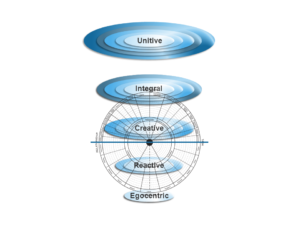Five Levels of Leadership
Your structure of mind drives your level of leadership.
By Bob Anderson and Bill Adams
Leaders develop through a series of sequential stages that are universal and invariant. To ignore this reality is to jeopardize our efforts to transform organizations and develop effective leaders. No organization can organize at a higher stage of development than the consciousness of its leadership. Deep systemic change occurs only if we can be the change we want to see.
System design and effectiveness is interdependent with the Stage of Leadership. In a business transformation, as a critical mass of leaders within the organization develops to a new stage, a tipping point is reached, enabling the system to make and sustain a leap from one level to a higher-order of the five levels of leadership and system performance: 1) Egocentric, 2) Reactive, 3) Creative, 4) Integral and 5) Unitive.
 1. Egocentric. The identity at the Egocentric level is “I am my needs.” We are identified with our ability to meet our needs. This identity does not notice other’s (often-competing) needs. At this stage our needs are primary. We are islands onto ourselves, and we relate to others primarily to get our needs met. Growth at this phase is taking others’ needs and expectations into account. It requires defining ourselves co-relationally, such that our primary loyalty is no longer to ourselves, but to the relationship (friend, parent, family, organization, community).
1. Egocentric. The identity at the Egocentric level is “I am my needs.” We are identified with our ability to meet our needs. This identity does not notice other’s (often-competing) needs. At this stage our needs are primary. We are islands onto ourselves, and we relate to others primarily to get our needs met. Growth at this phase is taking others’ needs and expectations into account. It requires defining ourselves co-relationally, such that our primary loyalty is no longer to ourselves, but to the relationship (friend, parent, family, organization, community).
The five percent of leaders who do not fully make this transition and continue to operate with an Egocentric Mind tend to be autocratic and controlling, dictatorial and oppressive —“my way or the highway.” Egocentric Mind in adolescence is normal. In adulthood, it is pathology. In leadership, it is destructive. Egocentric leadership is responsible for oppressive dictatorships, Fascism, Nazism, terrorist extremism, ethnic cleansing, gang violence, and immoral governance.
2. Reactive. The ability to hold both our needs and the needs/feelings of others simultaneously is the hallmark of the Reactive level. We learn societal rules and play by them in order to meet expectations. We dive into our chosen professions and work hard on honing our outer game. We gain the Domain Knowledge required to succeed in a chosen field. We create businesses, build careers, climb ladders, get married, have families, and establish the homestead.
Leaders at the Reactive Level often care deeply about their employees and manage and function as benevolent parents or patriarchs/matriarchs. The organization is ordered and efficient. It is competency driven and mechanistic. It uses all of the scientific management tools. Employee input is solicited, but decision-making and creative expression are still vested with top leaders. Leadership is often humane, but lacks the capability of broadly sharing power. People are informed but not involved in decision-making. People feel supported financially and treated fairly, but most are not expected to be involved in important decisions. The institutional style that emerges with Reactive leadership is a large, efficient hierarchy—an ordered and layered bureaucracy. Its political climate requires loyalty and obedience.
3. Creative. Most change efforts are attempts to create a Creative culture that is flatter, leaner, more agile, and requires higher ownership and creative involvement at lower levels. Such change efforts can only succeed if the leadership is functioning with the Creative Mind.
At the Creative level, we shed some old assumptions that have been running us all our lives; and we initiate a more authentic version of ourselves. By shedding well-patterned assumptions, we start to see the habitual ways of thinking that form the core of the Reactive Mind. They have served us well but are now reaching operational limits—they are not complex enough for the complexity of life and leadership into which we have grown.
By initiating a more authentic self, we begin to ask new questions: Who am I? What do I really want? What do I care most about? What do I stand for? How can I make my life and my leadership a creative expression of what matters most? We become visionary leaders.
As new possibilities open up, we begin to orient our life and leadership more on our sense of personal purpose and vision. Transitioning to the Creative Self is the major transition of life and leadership. To make this transition, we no longer ignore the unique call of the soul.
Creative leadership is required to create lean, innovative, visionary, creative, agile, high-involvement, high-fulfillment organizations—and to evolve adaptive designs and cultures. The focus is on high performance through teamwork and self-development. Leadership is shared. The leader now takes responsibility for authoring the vision, enrolling others in the vision, and helping them discover how the vision enables them to fulfill their personal purposes collectively.
4. Integral. This level of leadership is capable of leading amid complexity. The vision of the Creative leader expands to include systemic welfare—Systems Thinking and Design. The Integral leader holds a larger vision of the welfare of the whole system and becomes the architect of its future. Integral leaders focus on a vision not only for their organization, but also for the welfare of the larger system in which their organization is embedded and interdependent. At this stage, Servant Leadership fully emerges. The leader becomes the servant of the whole.
Integral level leaders become systemically and community oriented. The workplace becomes a self-renewing organization where members are true participating partners. The legacy of the leader is connected to developing the organization into a vehicle for service to a larger constituency. The organization is seen as a network of stakeholders nested within a larger system of networks. Vision often becomes global and oriented toward service to human welfare. Sustainability and long-term common good become salient values.
5. Unitive. This is the highest stage of awareness of who we are—a sacred union with All that Is. Spiritual practices, such as meditation and contemplative prayer, accelerate our development through the stages. In fact, the Unitive Self seldom, if ever, develops without a long-term spiritual practice. Initially, at the Unitive level, the self realizes, “I am not the body, nor the mind, but a soul—an essential self in communion with the Divine. As this Unitive Self acts in the world, it becomes a highly effective tool of the spirit. Further into Unitive realization, the astonishing oneness underlying diversity becomes obvious. We ecstatically experience the world as one. This oneness is an experience of oneness with life—the oneness of all things with Itself. This is the birth of universal compassion: “I am my brother and my sister. We are all each other! The earth and all beings are one life.”
Unitive development does not mean disengagement from the world. Quite the contrary, leaders at this level function as global visionaries and enact world service for the universal good. From the perspective of Unity, we are all each other. There is only one family. The ecosystem is our body. It is only from the presumption of the inherent indivisibility of all things that we will find the solutions, on a planetary scale, to our current predicaments.
We live in a time of great opportunity and great peril. The next 50 years will be pivotal. We could either create a new and vital global order of planetary welfare or destroy ourselves. With their global reach, business leaders play a major role in the world’s future. The evolution of ever more effective and conscious leaders is not only a business imperative as complexity escalates, but a global requirement.
# # #
Excerpted from Mastering Leadership: An Integrated Framework for Breakthrough Performance and Extraordinary Business Results, by Robert J. Anderson and William A. Adams (Wiley, 2015)
Bob Anderson is Chairman and Chief Development Officer and Bill Adams is CEO of The Leadership Circle and the Full Circle Group. They are coauthors of Mastering Leadership (Wiley). Visit www.fcg-global.com or http://www.leadershipcircle.com.






Dear Sir,
Reading through the Leadership Circle was an enlightening experience. Finally, someone has been able to integrate the contemporary knowledge , thought processes & wisdom of ages to get a coherent & consistent framework which is able to replicate the understanding of evolution of systems & become ready to create sustainable applications.
My salutations to you for giving birth to this concept which was lying under the debris of ages!
Ranjan Gaur